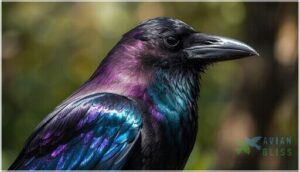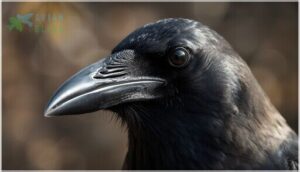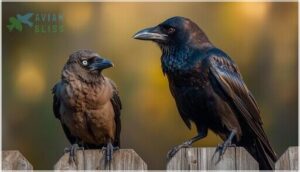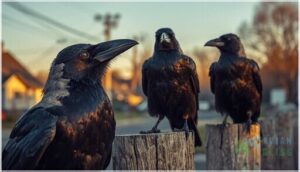This site is supported by our readers. We may earn a commission, at no cost to you, if you purchase through links.
You’ve probably walked past an American crow a hundred times without giving it much thought—just another black bird picking at yesterday’s lunch in a parking lot. But that casual dismissal misses one of nature’s most complex minds wrapped in feathers.
The American crow doesn’t just survive alongside humans; it outsmarts us, remembers our faces for years, and solves puzzles that stump toddlers. These birds operate in complex family networks, communicate through distinct vocal dialects, and demonstrate tool use that rivals primates.
Understanding what separates a crow from its lookalike cousins—and recognizing the intelligence behind those obsidian eyes—transforms every sighting from background noise into a glimpse of avian genius adapting to our concrete jungles.
Table Of Contents
- Key Takeaways
- American Crow Identification and Classification
- Physical Traits and Unique Features
- Habitat, Range, and Adaptation
- Diet, Foraging, and Feeding Habits
- Behavior, Social Structure, and Intelligence
- Frequently Asked Questions (FAQs)
- Is an American crow a raven?
- How can you tell an American crow?
- What is the difference between a carrion crow and an American crow?
- How big do American Crows get?
- How long do American crows live?
- Do American crows migrate?
- How do American crows communicate?
- What predators do American crows face?
- Can American crows be kept as pets?
- How long do American crows live in the wild?
- Conclusion
Key Takeaways
- American crows demonstrate intelligence rivaling seven-year-old children through tool use, problem-solving experiments, and statistical reasoning abilities that challenge conventional understanding of avian cognition.
- These birds operate within cooperative family units of up to 15 individuals where offspring remain with parents for multiple years, learning foraging strategies and survival tactics through direct observation and social transmission.
- Urban adaptation has fundamentally reshaped crow behavior since the 1960s, with populations thriving at densities of 80 birds per survey route in some regions by exploiting human food waste, adjusting nesting patterns, and demonstrating increased survival rates despite environmental pressures.
- Vocal communication extends beyond simple caws to encompass over 100 distinct sounds with measurable individual identity markers, achieving 66.7% acoustic accuracy in sex identification and enabling complex information sharing across communal roosts exceeding two million birds.
American Crow Identification and Classification
If you’ve ever spotted a large, all-black bird and wondered whether you’re looking at a crow or something else entirely, you’re not alone. The American Crow has a distinct identity rooted in science, but telling it apart from its cousins takes a trained eye.
Let’s break down the taxonomy, physical traits, and key identification markers that separate this bird from the rest.
Scientific Name and Taxonomy
You’ll find the American crow classified as Corvus brachyrhynchos, first described in 1822. This avian species belongs to the Corvidae family within Passeriformes, part of a genus containing roughly 46 crow, raven, and rook species.
Genomic analysis reveals it diverged about 5 million years ago, with phylogenetic trees showing close ties to Eurasian carrion crows—parallel hunters occupying similar ecological niches.
The American crow’s behavior and intelligence can be further understood by studying its outdoor Alabama habitats and patterns.
Physical Characteristics and Size
Beyond taxonomy, you’ll recognize Corvus brachyrhynchos by its physical attributes and abilities. These birds measure 40 to 53 cm in length, with an 85 to 100 cm wing span. Feather color is entirely black with iridescent sheen. Body proportions reveal males averaging 20% larger than females, weighing 316 to 620 grams. Beak structure shows a thick, straight profile with bristle-covered nostrils—hallmark American crow characteristics showing size variation across regions.
The American crow’s social behavior is characterized by complex social structures.
Distinguishing Crows From Ravens
You’ll separate American Crow from Common Raven through specific field marks and behavior. Size variation offers your first clue—ravens stretch 24-27 inches versus crows at 16-21. Vocalization patterns differ dramatically: crows deliver sharp “caws” while ravens produce throaty croaks. Watch for tail identification in flight, beak comparison at rest, and feather texture on the throat.
Five Markers That Break Identification Wide Open:
- Tail shape reveals species instantly—crows fan their tails evenly, ravens show wedge-shaped spreads
- Beak structure tells the truth—ravens carry thick, curved bills while crows sport straight, slender ones
- Flight style exposes identity—ravens soar and glide gracefully, crows flap continuously with steady beats
- Throat feathers don’t lie—ravens display shaggy hackles, crows maintain smooth neck plumage
- Wing fingers count differently—ravens show four primary “fingers” in flight, crows present five distinct tips
Regional Variation and Identification Challenges
Geographic hybridization complicates American Crow identification across hybrid zones. You’ll face regional morphology challenges—western birds run smaller, Florida crows sport oversized feet, and Pacific Northwest populations blend genetically with Northwestern Crows. Genomic studies expose species overlap where phenotypic traits fail identification.
Bird Identification Information reveals that morphological traits—size, plumage, voice—won’t reliably distinguish populations in hybrid zones. You’ll need genomic analysis for accurate bird species overview classification.
| Region | Size Variation | Distinctive Feature |
|---|---|---|
| Pacific Northwest | Slightly smaller | Deeper vocalizations, coastal habitat |
| Eastern populations | Larger overall | Standard crow morphology |
| Florida | Smaller body | Strikingly enlarged feet |
| British Columbia | Variable | Extensive Genetic Variation, late-generation hybrids |
Physical Traits and Unique Features
You can spot an American crow by more than just its color. Once you know what to look for, the details start to tell a clearer story—from the shine of its feathers to the way it moves through the air.
Here’s what sets these birds apart physically.
All-Black Iridescent Plumage
You’ll notice the American crow’s plumage isn’t simply black—it’s a showcase of striking iridescence. Under direct light, those feathers shimmer with purple, blue, and green hues, thanks to thin melanin layers within specialized melanosomes that act like microscopic prisms.
This feather structure creates color perception through light interference, not pigment alone.
The adaptive camouflage benefits are real: that iridescence shifts with viewing angle, helping these avian species blend into varying light conditions while aiding bird identification.
Beak Shape and Structure
The American crow’s beak runs about 2 to 2.5 inches long—short, straight, and built like a multitool. Keratin layers over bone create a structure tough enough to crack nuts and delicate enough for tool use.
This beak morphology enables omnivorous feeding adaptations, from tearing carrion to probing soil. It’s what makes bird identification easier and reflects how avian species evolve for survival.
Juvenile Vs. Adult Appearance
You’ll spot juvenile American crows by their striking blue eyes—these fade to dark brown during their first year. Pink mouth corners signal youth, while worn feather edges reveal age.
Plumage development shows brownish, dull feathers before the first molt brings adult iridescence. Size variation between juveniles and adults remains minimal, though beak formation and feather molting patterns tell the real story of bird identification in these avian species.
Flight Style and Vocalizations
You’ll recognize American Crow flight patterns by their steady, methodical wingbeats—rarely gliding like ravens. Aerodynamic wings support sustained flight, enabling these birds to maintain speeds of 30 to 60 mph during travel, with migration routes extending up to 1,740 miles.
Their vocal learning produces 9 to 23 distinct call variations, encoding individual identity through acoustic structure. Vocalization fulfills essential bird behavior needs, from territory defense to family coordination.
Habitat, Range, and Adaptation
American crows have mastered the art of living just about anywhere across the lower 48 states, from wild coastlines to concrete jungles. Their ability to thrive in human-dominated landscapes sets them apart from many native species.
Here’s where you’ll find these adaptable birds and what their distribution tells us about their exceptional survival skills.
Geographic Distribution in North America
You’ll find crows from coast to coast—their continental range spans nearly every corner of North America, from the Pacific to the Atlantic.
Population density peaks in the Southeast, where roadside surveys count 80 birds per route in Virginia. Seasonal migration patterns show 86% of eastern populations traveling south, while urban expansion continues pushing range trends northward across the Great Plains ecosystem.
Preferred Habitats and Urban Presence
You won’t see crows clinging to deep forest shadows—they break free in open space where resources flow. Their habitat adaptability is legendary, thriving across farmland, city parks, and suburban sprawl where human impact creates abundant feeding opportunities.
- Urban environments host millions, with nesting sites in large, dense-canopy trees
- Crow urbanization accelerated since the 1960s as cities expanded
- Open space near landfills and food waste areas attracts communal feeding
- Habitat fragmentation barely slows them—they colonize wherever opportunity knocks
Range Overlap With Similar Species
American Crow ranges collide with Common Raven overlap zones across Appalachian peaks and northern states, where Fish Crow ID challenges emerge along Atlantic shores thanks to nasal calls, and Northwestern Crow calls blur distinctions near Seattle.
Bird Species Distribution maps reveal hybridization potential exists but remains rare. Seasonal range shifts complicate Bird Identification as Canadian populations push southward each winter, mixing species in communal roosts where careful observation separates one black silhouette from another.
Population Size and Trends
You’ll find roughly 28 million American Crows across North America today, with roosting population dynamics revealing communal gatherings that can exceed two million birds.
Historical population shifts since the 1900s show striking urban population growth—around 2.9% annually in cities like Portland—despite past eradication campaigns.
Their conservation status review confirms “Least Concern” thanks to adaptable bird species distribution patterns that thrive amid human-wildlife conflict zones.
Diet, Foraging, and Feeding Habits
American crows don’t follow a strict menu—they eat what works, from insects and seeds to carrion and backyard scraps. Their feeding behavior shows resourcefulness that borders on strategic, whether they’re cracking nuts on pavement or raiding another bird’s nest.
Here’s how these adaptable foragers find, share, and stash their meals.
Omnivorous Diet and Food Sources
You’ll find American Crows thriving on a remarkably omnivorous diet—roughly 72% plant matter and 28% animal prey. Their menu spans corn, acorns, walnuts, wild grapes, insects, earthworms, small mammals, amphibians, bird eggs, and even carrion.
Seasonal variation drives diet composition: summer brings protein-rich insects and nestlings, while autumn shifts toward nuts and cached seeds, showcasing impressive foraging behavior and urban diet adaptability.
Foraging Strategies and Techniques
Beyond knowing what crows eat, you’ll want to understand how they hunt. Ground foraging dominates their technique—you’ll spot them probing soil, flicking leaves, and tilting debris with surgical precision.
Their repertoire includes surprising moves:
- Tool use in captivity reveals problem-solving with hooks and probes
- Caching behavior hides nuts year-round, sometimes using fake stashes to fool rivals
- Communal foraging in winter flocks exploits diverse landscapes at dawn
- Seasonal variability shifts tactics from insect-chasing in summer to scavenging cached seeds when snow flies
Scavenging and Human Food Interaction
Opportunistically, you’ll find American Crows mastering urban food waste alongside natural prey. Carrion consumption remains minor—roadkill and carcasses attract them, but garbage dumps, pet food, and kitchen scraps primarily fuel their survival in cities. Their dietary adaptation reshapes ecosystem impact through accelerated decomposition and waste reduction. Social scavenging thrives in these environments: alarm calls recruit others to carcasses, while deceptive caching tricks competitors, proving intelligence drives every meal.
| Food Source | Scavenging Context |
|---|---|
| Roadkill & carrion | Rural/suburban fringes, social recruitment |
| Trash bins & dumpsters | Urban centers, large roost densities |
| Pet food & scraps | Backyards, human-modified landscapes |
| Agricultural waste | Farmlands, seasonal opportunism |
| Processed foods | Cities during high human activity |
Communal Feeding and Food Storage
During fall and winter, you’ll witness cooperative foraging at its peak—thousands roosting together to share information, defend caches, and exploit abundant food sources. Scatter hoarding minimizes cache pilfering: about 80% stay hidden, often relocated when dominance threats emerge. Urban caching adjusts to rooftops and ledges, while seasonal variation shifts reliance between stored nuts and fresh invertebrates, defining American Crow feeding habits.
- Dominant individuals aggressively defend scattered caches from pilferers
- Strategic re-caching deceives competitors observing food sources
- Urban rooftops become visible storage sites during shortages
- Family units cooperate, improving foraging behaviors and resource sharing
- Winter scavenging increases reliance on human-generated waste
Behavior, Social Structure, and Intelligence
American crows aren’t just surviving alongside humans—they’re outsmarting us. Their social dynamics rival those of primates, and their problem-solving abilities challenge what we believe about bird intelligence.
You’ll discover how these black-feathered strategists communicate, cooperate, and adapt in ways that might make you see your backyard visitors in an entirely new light.
Social Groups and Family Bonds
You’ll find American Crows thriving in cooperative breeding arrangements within family territories, where offspring remain alongside parents for multiple years, strengthening social bonds and enabling social learning.
These family groups, spanning up to 15 individuals, foster territorial behaviour and complex social behaviors. However, disease impact and inbreeding effects present challenges—with only 4% urban juvenile survival at six months and roughly 20% inbreeding occurrence affecting offspring fitness.
Complex Vocalizations and Communication
You’ll discover American Crow vocalizations are remarkably complex—they produce at least ten distinct “caw” types plus rattles and coos, each serving specific purposes.
Their vocal repertoire demonstrates call individuality, with acoustic analysis revealing 66.7% accuracy in identifying caller sex and 24% for individual identity.
This contextual flexibility allows crows to modulate pitch, duration, and structure based on social influences and behavioral context, making their bird calls uniquely adaptive.
Problem-Solving and Tool Use
You’ll witness cognitive experiments revealing that American Crow behavior surpasses expectations—their brain size correlates with problem-solving abilities, particularly in string-pulling tasks where neural activation patterns differ between tool use and basic intelligence.
Social learning fuels advancement, as juveniles master foraging behaviors by observing family members. Bird behavior studies confirm crows employ statistical reasoning and flexible tool use, demonstrating intelligence comparable to seven-year-old children in controlled settings.
Young crows learn tool use through observation, achieving problem-solving intelligence rivaling that of seven-year-old children
Adaptability to Human Environments
You’ll notice urban environments have reshaped American Crow adaptability through striking behavioral shifts. Human tolerance in cities reduces nest defense responses, while social learning allows these birds to exploit novel resources:
- Urban diet changes include fast food scavenging, raising cholesterol levels
- Nesting behavior shows earlier breeding with higher fledging success rates
- Survival rates increase in cities despite lower nestling body mass
Foraging behaviors and communal roosting make birdwatching in cities rewarding year-round.
Frequently Asked Questions (FAQs)
Is an American crow a raven?
No, they’re separate bird species. The American Crow measures roughly 17 inches, while ravens reach 24–27 inches. Vocal distinctions help too—crows caw; ravens croak. Flight patterns and plumage differences aid identification.
How can you tell an American crow?
You can identify an American crow through its glossy, all-black plumage iridescence, squared tail, straight bill, and distinctive caw-caaw-caaw call. Juveniles display blue eyes and pink mouths before maturity.
What is the difference between a carrion crow and an American crow?
You’ll find carrion crows in Europe and Asia, while American crows inhabit North America—distinct continents, no habitat overlap.
Both show black plumage iridescence, but vocal differences, size comparison, and genetic divergence separate these bird species.
How big do American Crows get?
Think of a raven’s shadow cast smaller—you’ll glimpse the American crow’s true size. These bird species measure 8 to 21 inches long, wingspan reaching 33 to 39 inches, weight averaging 11 to 22 ounces.
How long do American crows live?
Wild crow lifespan averages 7 to 8 years, though captive crow longevity reaches 20 years or more.
Juvenile mortality rate exceeds 50% in the first year, with West Nile impact and survival factors greatly affecting these bird species’ life cycle.
Do American crows migrate?
You’ll notice partial migration patterns across crow populations—73% of western and 86% of eastern birds head south around 310 miles when snow covers their breeding grounds, while southern subspecies stay put year-round.
How do American crows communicate?
Crows are masters of communication, wielding over 100 sounds like a sonic toolkit. You’ll hear them use vocal mimicry, alarm calls, and non-vocal cues.
Their acoustic structure reveals family communication patterns, defining avian behavior through complex vocalization.
What predators do American crows face?
You’ll encounter hawks, owls, and eagles as the primary avian predators targeting American crows, while mammalian threats include raccoons raiding nests.
Their aggressiveness and mobbing defense tactics greatly reduce successful predation attempts.
Can American crows be kept as pets?
You can’t legally keep American crows as pets under the Migratory Bird Treaty Act. Rehabilitation conditions require federal permits, and enforcement penalties include steep fines.
Ethical considerations and bird behavior patterns make captivity inappropriate anyway.
How long do American crows live in the wild?
Wild lifespan averages 7 to 8 years for these birds, though survival rates vary.
Urban vs. rural settings, mortality causes like disease and predation, plus longevity factors determine their life cycle and overall bird behavior patterns.
Conclusion
That black silhouette perched on your fence post isn’t just watching—it’s calculating, remembering, adapting. The American crow represents nature’s refusal to follow scripts, thriving where rigidity fails.
You’ve seen them your whole life, but recognizing their intelligence, social complexity, and problem-solving prowess transforms observation into respect.
Next time those obsidian eyes meet yours, remember: you’re not looking at a simple scavenger. You’re facing a feathered genius charting your world with fluid cunning.
- https://arstechnica.com/science/2023/09/for-the-first-time-research-reveals-crows-use-statistical-logic/
- https://carolinaraptorcenter.org/wp-content/uploads/2025/03/American-Crow-Reference-Sheet.pdf
- https://science.ebird.org/status-and-trends/species/amecro/abundance-map
- https://zipatlas.com/us/city-comparison/percentage-crow-population.htm
- https://www.audubon.org/field-guide/bird/american-crow











